|
Polikarpov I-16 Type 24
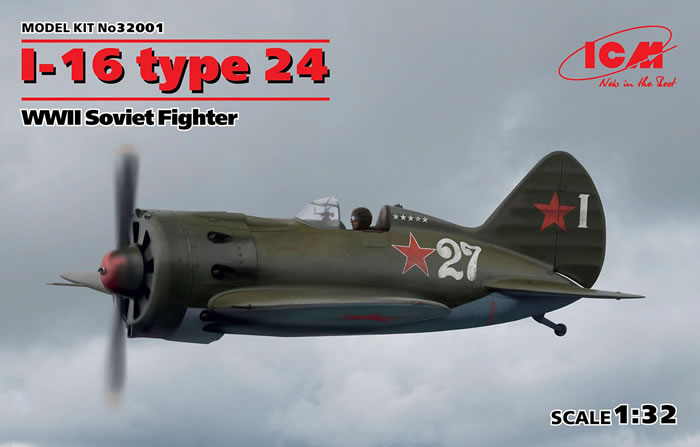
ICM, 1/32 scale
S u m m a r y : |
Catalogue Number: |
ICM Kit No. 32001 - I-16 Type 24 |
Scale: |
1/32 |
Contents & Media |
Three sprues of medium-grey styrene and one of clear, decals for four marking options. |
Price: |
USD$55.99 plus shipping available online from Squadron
£27.99 (£23.33 Export) plus shipping available online from Hannants
Click here for currency conversion |
Review Type: |
First Look. |
Advantages: |
High quality plastic parts; high level of detail in the engine and cockpit; crisp and fine surface textures; comprehensive instructions. |
Disadvantages: |
No seat belts. |
Conclusion: |
ICM really does seem to have captured the stubby agricultural look of the I-16, but with finesse in both the cockpit and the engine areas. This doesn’t look a difficult kit to build. |
Reviewed by James Hatch

ICM's 1/32 scale I-16 Type 24 is available online from Squadron.com
The Polikarpov I-16 was a Soviet fighter aircraft of revolutionary design; it was the world's first low-wing cantilever monoplane fighter with retractable landing gear, to attain operational status and as such has been described as having "introduced a new vogue in fighter design.
The I-16 was introduced in the mid-1930s and formed the backbone of the Soviet Air Force at the beginning of World War II. The diminutive fighter, nicknamed "Ishak" (Donkey) or "Ishachok" (Burro) by Soviet pilots, figured prominently in the Second Sino-Japanese War, the Battle of Khalkhin Gol, and the Spanish Civil War, where it was called the Rata (Rat) by the Nationalists or Mosca (Fly) by the Republicans.
Full-scale work on the TsKB-12 prototype began in June 1933, and the aircraft was accepted into production on 22 November 1933, a month before it took to the air. The TsKB-12 was of mixed construction, using a wooden monocoque fuselage and wings employing a KhMA chrome-molybdenum steel alloy wing spar, duralumin ribs and D1 aluminium alloy skinning on the centre and leading edges, with the remaining portions of the wings fabric covered. Another modern feature were the ailerons which ran along almost the entire trailing edge of the wing and also operated as flaps.
The cockpit was covered by a 16” wide canopy which featured an Aldis-type tubular gun sight which could slide back and forth on runners fitted with rubber bungee cords.
The main landing gear was fully retractable by means of a hand crank.
The armament consisted of a pair of 7.62×54mmR (0.30 in) ShKAS machine guns in the wings, mounted on the outboard side of the main gear and 900 rounds of ammunition.
Service trials of the new fighter, designated I-16, began on 22 March 1934. The M-22 prototype reached 223 mph. The manually retracted landing gear was prone to jamming and required considerable strength from the pilot. Most of the test flights were performed with the gear extended.
On 1 May 1934, the M-22 prototype participated in the flyover of Red Square. Engine improvements etc. pushed the types top speed to 326 mph for the Type 24, that we see in this article. Initial service experience revealed that the ShKAS machine guns had a tendency to jam. This was the result of the guns being installed in the wings upside-down to facilitate the fit. The problem was addressed in later modifications.
The I-16 was a difficult fighter to fly. The pilots had poor visibility, the canopy tended to become fouled with engine oil, and the moving portion was prone to slamming shut during hard manoeuvres, which caused many pilots to fix it in the open position. The front section of the fuselage, with the engine, was too close to the centre of gravity, and the pilot's cockpit too far to the rear. The Polikarpov had insufficient longitudinal stability and it was impossible to fly the aircraft "hands off".
Production lasted from between 1934 to 1942, and totalled over 8600 machines.
The Kit
I’m quite a fan of ICM’s approach to boxing their products, and here we see their first foray into 1/32 with the I-16 Type 24.
As per the current crop of samples that we have been sent for review, this kit is packaged into a very sturdy corrugated cardboard box that opens via a tab, and the box itself has a product lid which sits over the top of this. The artwork here shows a single I-16 in level flight with a cloud base background.
On the lid sides, two out of the four supplied schemes, are shown in profile format.
Inside the box, a single, large cellophane sleeve contains the three medium-grey styrene sprues that make up this diminutive little fighter aircraft, plus a single clear sprue that is further protected by another sleeve.
There are no PE or resin parts in this release, and this package is completed with a 12-page A4 instruction manual and one decal sheet that is placed within.
I saw a Rata a few years ago at Duxford, close up and personal, and then had the pleasure of seeing the little tin can fly afterwards. This was always going to be a subject that would appeal to me, so to see a modern tooling of this important type was always going to excite me somewhat.
Sprue A
You really do get an idea of just how squat the I-16 was when you take a look at the fuselage halves on this sprue. Even more so if you then contrast those dimensions against the wing itself. Note how ICM has tooled this kit, with those fuselage parts standing very high on this sprue. The run of the sprue itself protects the relatively vulnerable wing root protrusion whilst not actually being connected. Due to the nature of the I-16’s wooden construction, there isn’t much in the way of detail on the fuselage halves, except for the tail fin and fairings for this and the stabiliser. The fin has a rather nice representation of the fabric and rib structures, with this perhaps being a tad heavy in places, but nonetheless very nice in its depiction. Some rivet and fastener detail exists around the fairing, and the rear starboard fuselage has raised access panel detail. The rudder and forward engine cowls are moulded as separate parts. Internally, fuselage detail is straightforward and simple, but sharply executed. This consists of formers and longeron strips, and you will have to eliminate a single ejector pin mark in these areas, but that’s not too bad. To quote an oft-used and maligned phrase….simple modelling skills.
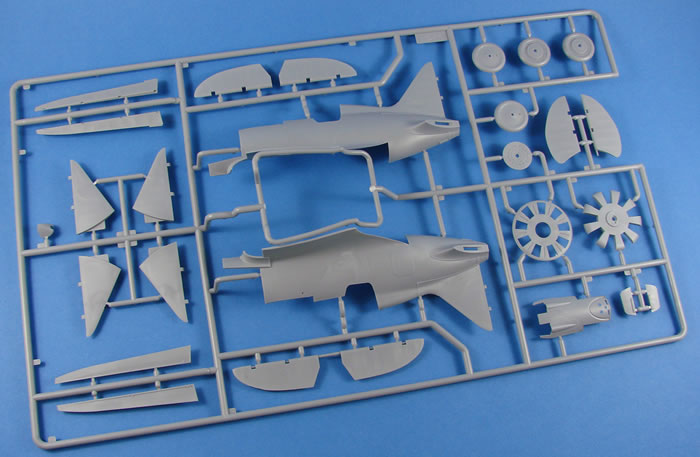
Also moulded here are the stabilisers, ailerons, elevators and rudders. In traditional construction style, these are supplied as upper and lower parts, with the elevator itself being full-span. Rib and fabric details of course extend onto these parts, and to me at least, these look perfectly acceptable. All control surfaces are designed to be moveable too.
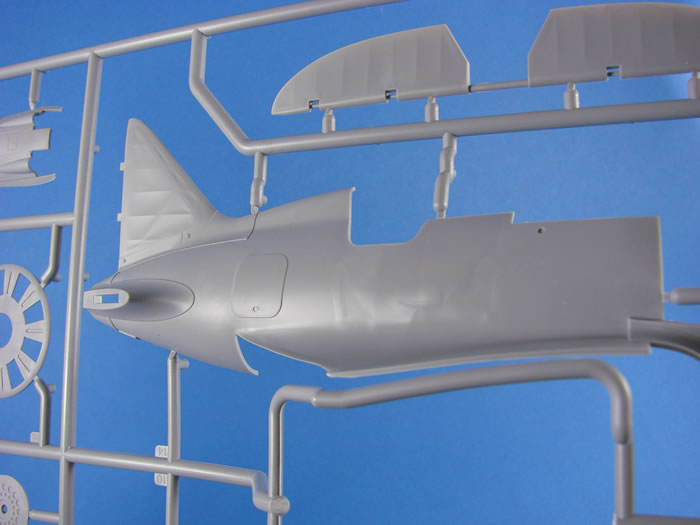
Within the engine cowl are two plates that go to make part of the cooling shutter mechanism, and this is designed to be left free of glue so that it may be positioned. Other parts on this sprue include the upper gun cowl, both cockpit entry doors, and also the main wheels. These are supplied as halves, but they aren’t weighted.
Sprue B
ICM has sensibly designed this model to have a full span lower wing, and this is packed with details, from the basic rib and fabric structures, to the various plates that are moulded in situ, representing the panels that cover the ShVAK cannon locations and the undercarriage bay etc. The main gear wells are simply that….wells, but look very reasonable when you reference this to photos of the actual thing. Note that there is a circular hole in each well, coinciding with the central wheel hub. This was there for a reason. That gear was cranked upwards by hand, and this is where the cable would pass through to the wheel hub. However, ICM make no reference to this, and to the cable you would need to add for this to look accurate. Take note! As was noted earlier, the ailerons are separate parts here and can be posed however you wish. The upper wing panels exhibit the same degree of detail as the lower span part, with good plate detail over the cannon areas, looking suitably agricultural, as befitted the I-16.
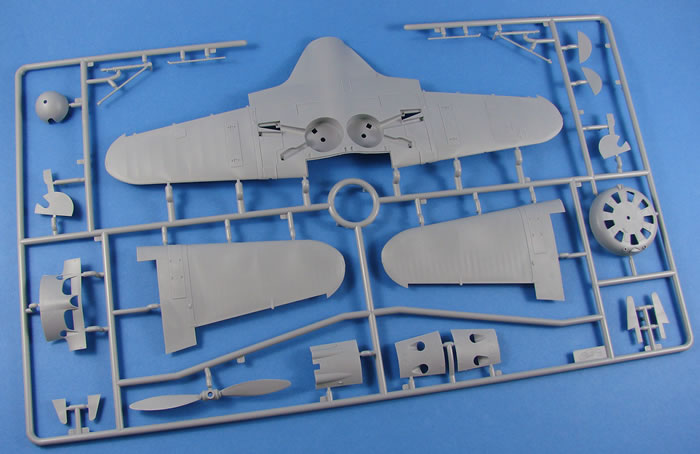
The rest of the undercarriage parts are found here, and these do look a little fragile, but are simply and authentically detailed. This also applies to the undercarriage doors, but I do wonder if there are some small bracing details missing from the rear of the upper semi-circular plate, as my references tend to show these. I could be wrong, and they may or may not pertain to the Type 24. Check your references.
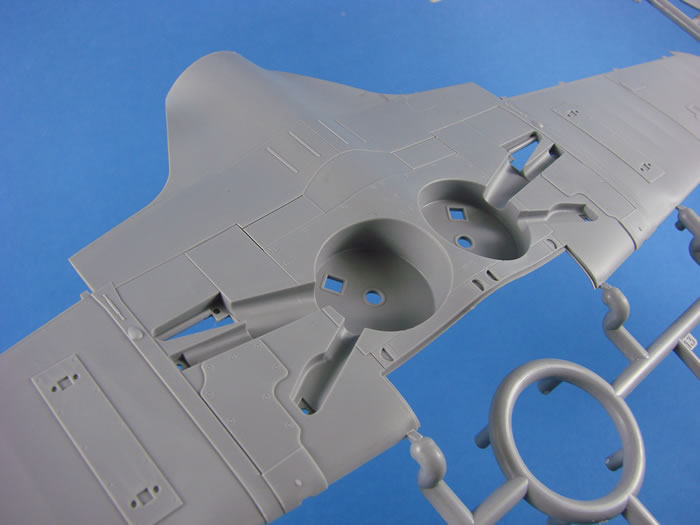
Other parts on this sprue include the cowl plates with their open scoop details, the main front engine cowl with cooling apertures, lower cowl to wing fairing, and the squat spinner and separate propeller with hub details.
Sprue C
For a 1/32 model, this kit sure doesn’t have masses of parts, but it has that detail exactly where it counts. Here we see parts that are for both the engine and cockpit. The Soviet Ash-62 engine that powered the Type 24, actually had its roots in the Wright R-1820 Cyclone. That engine in particular had been built under licence in Russia, and the Rata’s engine was a development of that powerplant. ICM has produced quite a nice representation of this engine, comprising of about 18 parts, including the separate exhaust stubs and engine mount. Cylinder cooling fin detail is fine, and about the only thing I think this wold benefit from would be some ignition wiring and the missing ignition distribution ring….that’s if you plan to maybe pose a cowl section off the model, so you can see at least some of this engine.

Apart from the two cowl-mounted ShKAS machine guns (which look incredibly good), pretty much everything else on this sprue is to do with the cockpit, which really is superbly detailed. In here you will find detailed forward and rear bulkheads, cockpit floor, pilot seat with cushion, compressed gas tanks, rudder bar and control stick, plus the various pieces of equipment that were bolted to the inner sidewalls. About the only thing that will be required here is some lead wire etc. to plumb these items in. Reference photos tend to show cables that were clipped to the various internal structures.

Other parts seen here are the engine firewall and oil tank, propeller counterweights, tail cone, static air chamber, pitot, and the channels for the machine guns.
Sprue D
Only eight parts are moulded on this clear sprue. These are for the windscreen, instrument panel, gunsight and various lamps. Windscreen framing is subtle but should be easy enough to mask, and the instrument panel is quite simple, as befits this machine.
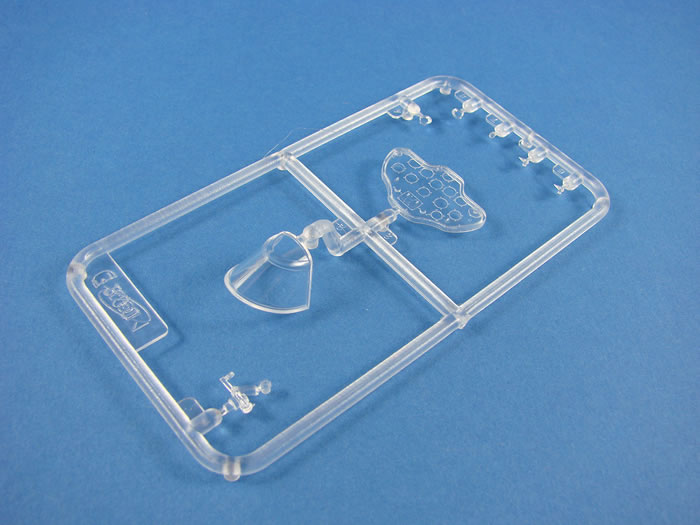
A decal is supplied for the instrument panel, but I suggest punching out the individual dials and adding them separately.
Decals
Just one medium-sized sheet is included here, with markings for FOUR aircraft. These are suitably thin, printed with solid and authentic colour, and with minimal carrier film. Everything looks to be perfect register too.

I’m particularly pleased that one machine is emblazoned in Cyrillic graffiti too. That would be my build of choice! The schemes included in this release are:
-
I-16 Type 24, 67th Fighter Regiment, South Front, Summer 1941
-
I-16 Type 24, 72d Mixed Regiment of the Northern Fleet Aviation, Summer 1941
-
I-16 Type 24, 4th Guard Fighter Regiment of the Baltic Fleet Aviation, Winter – Spring 1942
-
I-16 Type 24, 254th Fighter Regiment, Leningrad Front, Summer 1943
Instructions
The Rata’s construction is broken down into 59 sequences of assembly, which are all clearly drawn and very easy to follow. There are paint references given for Revell and Tamiya colours, and these are very clearly annotated throughout the 12-page instruction manual.
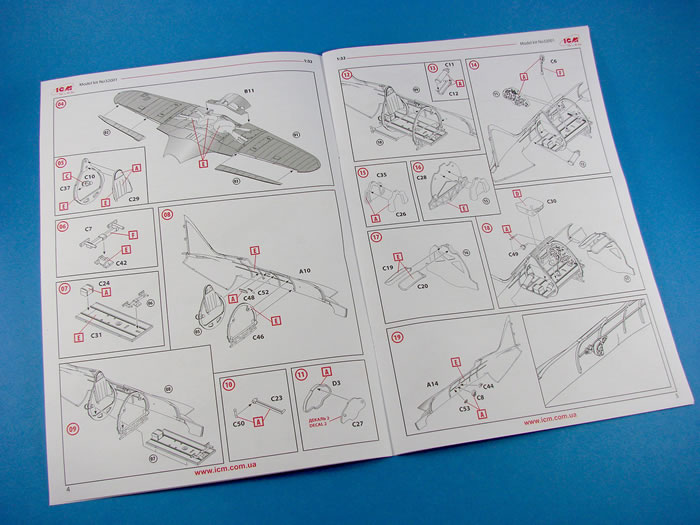
The last two pages are dedicated to the scheme profiles and decal placement guides for each machine.
It really is good to see a modern tooling of this stubby little aircraft, and with the beautiful details what ICM has furnished the kit with. They really do seem to have captured the agricultural look of the machine, but with the finesse of both the cockpit and the engine areas.
This doesn’t look a difficult kit to build, but I do suggest you look towards when Eduard’s sets can offer, especially with regard to things such as the missing seatbelts.
In all, a great little kit, and not too expensive either. Certainly a good number of hours of modelling to be had with this release.
My sincere thanks to ICM Model Kits for the review kit seen here./
Review Text and Images Copyright © 2018 by James Hatch
Page Created 11 January, 2018
Last updated
11 January, 2018
Back to HyperScale Main Page
Back to Reviews Page |
